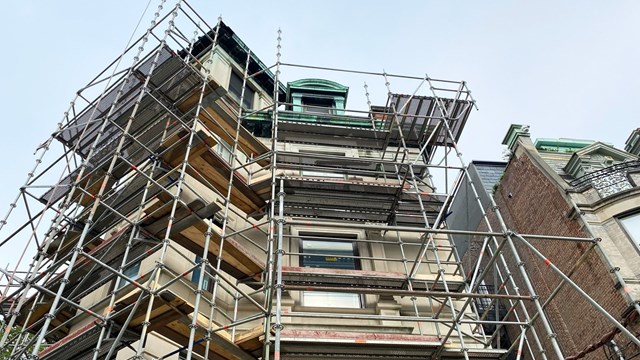It’s Spring, as the saying goes, and a young man’s fancy turns to love. Your co-op board, while they may be romantics at heart, smell Spring and their minds go to landscape maintenance. The landscaping of a property is the first thing visitors see; it adds value to the units and influences quality of life. Even so, many experts say not enough thought, time and money is going into this very important area. While it may be true that April showers bring May flowers, grooming the grounds is a January to December affair.
Robert Grant, director of Diversified Property Management, a company with offices in Brooklyn, Queens and Staten Island which manages over 4,000 units, has a passion for landscaping. Among Diversified’s clients are a 25-acre co-op complex in Queens and a ten-acre Staten Island Townhouse community. "[Property Managers] are always solving problems, fixing the leaks," Grant says, "Landscaping is the artistry and fun side of what we do." Grant follows a twelve month schedule for maintaining the grounds of his properties which includes not just planting, mowing, and weeding, but also soil preparation, pesticide spraying and disease control.
Landscaping Considerations
If you’ve decided that this is the year to spruce up your landscaping, there are several things to consider before sending the super off to Home Depot for some flats of impatiens. Grant recommends that buildings budget money for a landscape company and find one that does not only maintenance, but also has a knowledge of design. Even small buildings with limited funds can hire a consultant, and then save money by doing the work themselves.
Numerous factors affect what types of plants, trees, shrubs, and even grass, may be utilized on a particular property. A landscape designer examines many factors. How much light does the area get? What areas and views need enhancement or obstruction? What is the pitch of the land and the quality of the soil? What is the exposure of the landscaping to wind, pedestrians, and pets? Rooftop gardens have other considerations which include weight and construction restrictions imposed by the New York City Building codes, and soil-less planting mixtures. For every property, the answers and the combinations of plantings will be unique.
Madelyn Simon, president of Madelyn Simon and Associates Inc. based in Manhattan and the sixteenth largest landscaping business in the country, specializes in supplying and maintaining flowers and plants both indoors and out. She considers the aesthetics of both the exterior brickwork and the building interior when designing a courtyard. "I like to match the decor," says Simon. "I see what materials are being used in the lobby. You want the atmosphere to flow."
Two other factors to consider are safety and security. When choosing the types of shrubbery and their placement, you want to be sure you are not creating hiding places for predators, or obscuring first floor windows where intruders could break in unseen. Trees need to be placed far enough from the building so that their branches are not a danger to windows or constantly rubbing against the masonry. Garden apartment complexes need to keep tree branches well back from the roof, to keep the gutters as free of leaves as possible, and prevent squirrels and other rodents from getting onto the roof and perhaps into chimneys.
The Green Factor: Enhancing Value
Grant tells a story that highlights the importance of quality landscaping. Several years ago, he took over the management of a large property in Flushing, Queens. With only 20 percent owner occupancy and a poor loan-to-value ratio, the building was struggling to qualify for mortgage refinancing. Grant immediately sought to improve the financials, and allocated $30,000 for landscaping. "We transformed this property into a botanical garden," says Grant. "The loan officer saw the beauty of the property and made the loan."
The IRS calculates as must as 30 percent of a home’s value is in the landscaping. "The beautification of landscaping sells apartments and it sells lenders," adds Grant. "Not to mention improving quality of life."
Once begun, landscaping needs to be maintained. "It’s not enough to just do something and then leave it," says David Protell, president of Chelsea Garden Center, a company which features three retail garden centers and furnishings stores in Manhattan, in addition to the landscaping division which designs, delivers and maintains gardens. "We’re still maintaining projects ten years later. This is key to the life and beauty of the plants."
Securing Proper Maintenance
When bidding out a maintenance contract, it helps to prepare the specs, so that all the companies are bidding on the same work. Otherwise, experts say, you are trying to compare apples with oranges when looking at competitive pricing. Make sure that any company you are considering has adequate experience and insurance. Property managers recommend that you go and look at a company’s reference properties. Grant also recommends writing warranties into any landscape contract; if any plant turns sickly, it is replaced free of charge.
"Any shlemiel can hold a hose," states Richard Heller, president of Mornhurst Gardens, a company which designs, installs and maintains indoor and outdoor landscaping throughout Manhattan and Westchester. "It’s a big problem when people who don’t know anything are doing this work." Heller recommends a weekly schedule that identifies and reduces the stresses on the plants. These stresses include toxins in the soil, insects and, diseases. After any exterior work, brick dust and metals can fall into plant beds and poison the greenery. By monitoring the plants weekly, problems are spotted before they emerge. The soil can be fertilized and balanced and pesticide use can be minimized. This time of year lawns need to be limed and flower beds treated with herbicide. While many annuals such as marigolds and impatiens are to be planted now, the best time for planting bulbs and perennials is the fall, so that they winter in the ground and develop deep root systems.
Watering is an essential component of landscape maintenance. And while the building staff can do it, it may not be the best use of their time and the building’s money. Experts say that an in-ground sprinkler system will pay for itself by freeing the staff to do other things. It is important to have a landscape architect work with the sprinkler company to ensure that the system is functioning most efficiently for the type and location of lawns. Large garden complexes will want to be sure that the system has enough water pressure to saturate all areas equally. The amount of watering will be dictated by regional rainfall, but watering is best done at night, because during the day the sun’s warmth evaporates water before the soil can absorb what it needs. During the season of May to October, mowing is needed weekly.
Tree maintenance is a category of its own. "Tree maintenance is like dental care," says Walter Dages, vice president of public relations at Bartlett Tree Experts, a national company based in Westbury, New York. "Have a professional look at it twice a year and take care of the little things that pop-up and you’ll save money in the end." The number-one consideration with trees is safety and liability. Trees that have dead limbs and pose a hazard need to be corrected immediately. After that, the health and beauty of the tree needs to be nurtured.
Dutch Elm disease has decimated the trees that once graced the streets of New York. Those affected include maples, ash and dogwoods which are currently experiencing fungus problems that need attention. Having the trees examined yearly can minimize the spread of diseases and insects which afflict different species. "Ornamental trees should be pruned once a year," recommends Ken Almstead, president of Almstead Tree and Shrub Care Company, with offices in Westchester, Connecticut and New Jersey. "Mature species need care at least every five years." Coniferous trees need to be winterized every fall. Landscapers will spray the needles with an anti-desiccant to prevent water loss during the winter months, when the ground is frozen and the roots are receiving minimal nourishment.
After last summer’s mosquito problem and the Asian Beetle crisis on Long Island, insect and pest management is also a high priority in this area. "You need to get there when the bugs are out," says Dages. In May, for example, the gypsy moths start hatching. Constant monitoring, the use of dormant oil spray and eliminating stagnant water will all help control the insect population.
And what can be done about the bane of urban trees, dog urine? The experts recommend fencing in tree pits, or planting ornamentals to prevent dogs from getting too close to tree trunks. Almstead suggests that trees that have exposure to dogs be watered more frequently and never fertilized with a high salt content product.
"You get more out of a dollar spent on landscaping than anything else," sums up Grant. "For one-tenth of what it costs to re-do the lobby, you have created a beautiful environment where people want to live." With proper care, that investment keeps growing, and enriching the quality of life, for years to come.







Leave a Comment